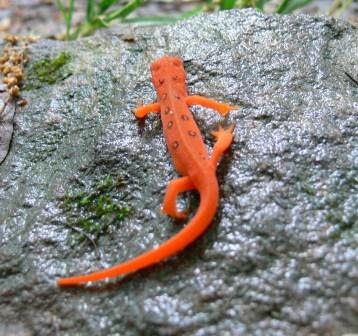
There is nothing more American than a little rebellion. In honor of Independence Day, I’m protesting the misuse of the word red.
There seem to be two definitions of red, the standard, “red, white and blue” and the more troubling red as in “red head.” This second use of the word is wrong.
In a wave of patriotic fervor, let’s clean up our language starting with a name change for the Red Eft. Let’s call it like we see it. I hereby declare the salamander formerly known as the Red Eft is now the Explosively Orange Eft.
Whatever you call it, this eft makes an arresting sight on drab rainy moist days in the woods. Neon orange is more than striking against the backdrop of browns, grays and greens of the forest. Even their slow side-winding walk is deliciously alluring. It draws you in, but don’t do it. Don’t kiss the “Red” Eft. No, not even one little peck. Don’t lick it either. They’re poisonous.
Likely that’s why you get to see them, being poisonous makes them bold. With their bright warning system they have no need for speed. They take their sweet time going about their business unabashed, more active during the day than your average salamander. For all this the Explosively Orange Eft is fairly commonly known, at least back east (they can be found roughly from
Red Efts are Red-Spotted Newts (aka Eastern Newts). The eft stage is all about terrestrial migration. For humans it’s the most visible phase of the life cycle. For the eft, it’s a few years of throw-it-to-the-wind carefree wandering. It’s a time when newts, who haven’t reached sexual maturity, hang around rotten mushrooms and chomp maggots. It’s a time of solitude, struggle and personal discovery. Efts will ramble alone, curling up in rotting logs for a cheap place to stay and breakfast in bed, termites, worms or whatever comes by. It’s idyllic.
But all good things must come to an end. After years of freedom these little newts return to their natal ponds to procreate. They trade in their screaming orange pigment for the same muted green brown that they crawled out of the pond in.
But don’t feel bad for them. They keep their spots. Little orange dots forever mark what they are and who they’ve been.
[Super special thank you to Jim McCormac for the use of his fantastic Red Eft pic. Check out his blog Ohio Birds and Biodiversity. It is full of gorgeous photography. I became aware of Red Efts on a three day family hiking adventure in




Way Cool and we need cool today!
ReplyDeleteYeah, we and all the little efts out there need some rain!
ReplyDeleteHey Annie,
ReplyDeleteJust a heads up, we took your advice and tracked down some grilled, salted seaweed, and yum! We gave you a shout out in this week's Bizarre Snacks installment. Thanks!